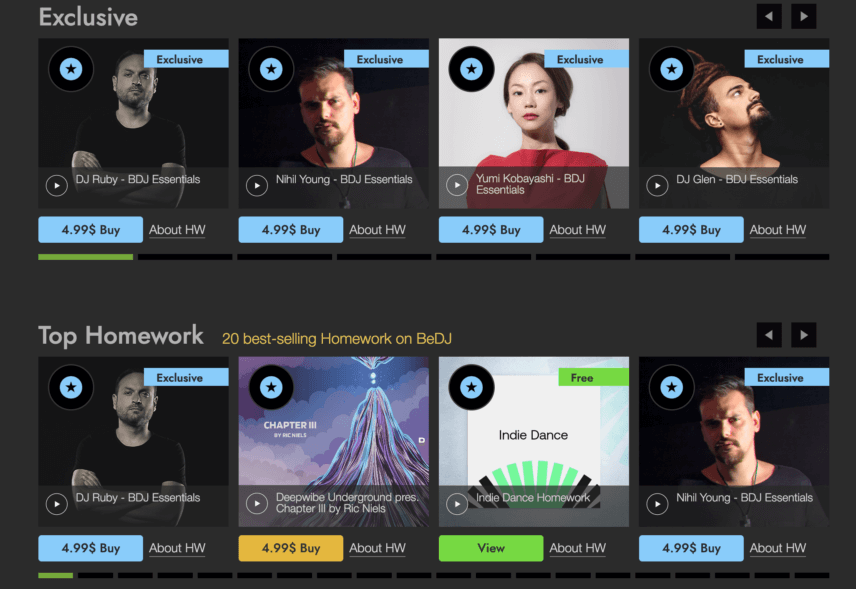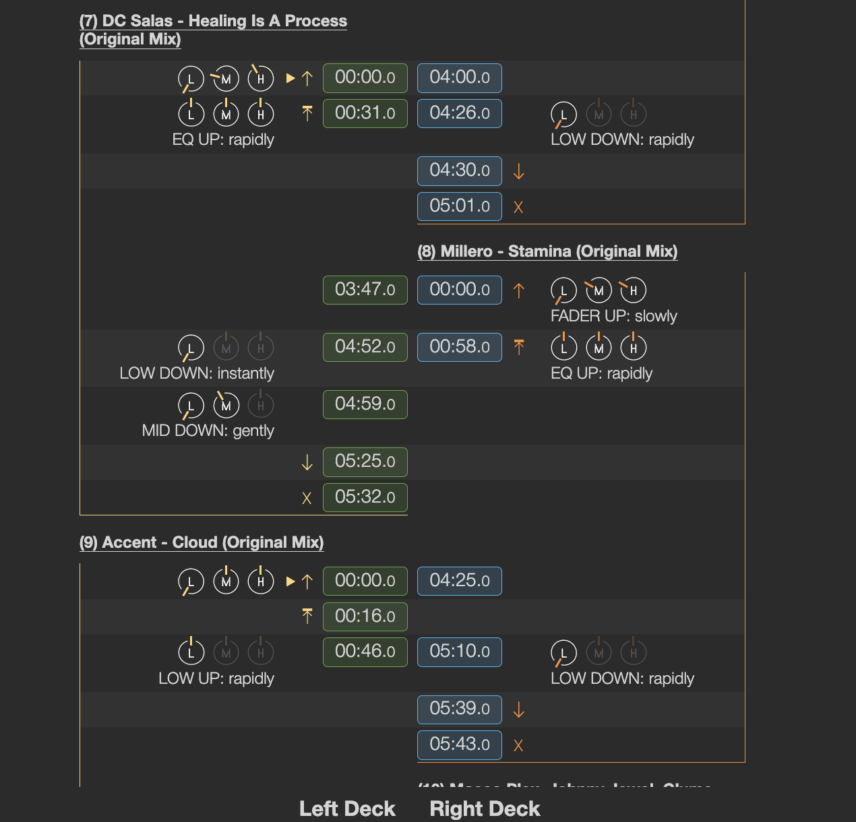Can BeDJ teach you every movement and mix position with a sheet music inspired timestamped DJ learning tool?
Whether you’re using vinyl, CDJs, controllers, or just your laptop – you can get to grips with the basics of DJing pretty fast. That’s things like starting tracks, managing the EQ, volume faders. Then you’ll be focused on tempo, and the dark arts of beatmatching. Track selection will come into it too, but that’s between you and your mp3 library.

Here’s a common scenario: You’ve had a few gigs. Hopped on a livestream, dropped the golden oldies at Aunt Sheila’s 65th. But something feels like it’s missing. Your mixes don’t quite gel like the DJs you listen to. The tracks don’t flow together so well; the joins are audible. The crucial art of DJing is controlling a flow of energy, sustained over many tracks that take the listeners on a journey. These are skills you can learn over the course of a lifetime, and they’re hard won.
This is what BeDJ is aiming to addresses. It offers users a selection of ‘Homeworks’ that offer precise instructions, step by step, to recreate an existing mix. Homework is documents that give timestamped directions of what tracks need to be played when to play them, and how to bring them in just right. You get a tracklist, and a link to acquire the tracks on Beatport or Soundcloud. Then, you open the Homework and follow the instructions to nail the mix. We decided to try this new educational tool, to see if it would help our skills. Before we get into it, ‘Homeworks’ could be considered a bit misleading as it’s actually a ‘breakdown’ of a mix and something to practice in your own time. It’s certainly more fun than the homework we all remember when we were younger..

Headling the Mainstage
I’ve always felt destined to be a festival headliner, so I had to try the ‘Mainstage’ homework first. For this, I’m using a Native Instrumentals controller and Traktor software. It’s worth noting that in this case, the homework is free, but the tracks are not. There’s a link to a Beatport playlist called Mainstage that has all the tracks, but you’ll need to buy them. However, there are free homeworks that use free-to-download tracks – such as this one. Just click the track titles to get them from Soundcloud. This would be a great place to start.
One of the first things you’ll see is the BPM range of the set – this one stayed at 127 all the way through. Changing BPM mid-set and beatmatching are important skills, but they’re not what I’m looking to get from BeDJ. Instead, I’m focused on getting tracks flowing together smoothly, with well-matched phrases. So I set the BPM from the start, using the sync function on my decks to keep it at 127.
I created a playlist of the tracks listed in the homework, chronologically organised. First up is Timmy Trumpet and Marianna BO’s ‘Vivaldi (Extended Mix)’. The homework shows me that it’s going to play out for over 4 minutes before I start the next track. Already, this is a useful lesson – when you’re feeling nervous, it’s easy to mix tracks too quickly. This can result in a set that feels rushed, and you might even run out of tunes.
At close to four minutes, I prepared the next track – David Guetta and Morten’s ‘Permanence (Extended Mix)’. I could see that the low EQ band needed to be all the way down to start, so I made that adjustment. The instructions indicated that at 04:08:00, I was to press play on ‘Permanence (Extended Mix)’. As this time approaches, I could hear the end of an eight-bar phrase approaching – focusing on this made it easier for me to get the timing right when I started the next track.
30 seconds into this new track, the Homework instructed me to slowly raise the volume fader. I did so, aiming to have it all the way up at one minute in when there was another action for me to follow. An important one – simultaneously, I cut the low EQ out from ‘Vivaldi Extended (Extended Mix)’ while bringing it up on ‘Permanence (Extended Mix)’. This is a crucial part of the mix, where the new track dominates the outgoing one. Afterwards, the Homework guided me to build on this effect and smooth out the track’s ending by gradually bringing the mid EQ down until it ended.
Going Deeper
I had a great time on the Mainstage. The crowd response was incredible! My Instagram following went through the roof. They’re making bottles of tequila with my face on them. But as day turns to night, you might be looking for something more subtle and slinky to rehearse.
Fortunately, there’s a variety of mixes on offer from BeDJ – on the site you can search by genre, or check out popular and recommended Homeworks.
I wanted to test out an alternative style, and this time used just my laptop to check out a different user experience. I selected the ‘Indie Dance’ Homework. Getting access to these tracks is extremely convenient if you have a Beatport account. Using their Beatport DJ app, I opened the playlist and DJing app with a single click from the BeDJ website. You can get a free trial for 30 days to try it out, accessing the app and all the tracks.
Starting with ‘19 – Original Mix’ from Miss Kittin and The Hacker, I loaded the track and set the BPM to 123. At 2:26 into this song, I started to bring in ‘Devil’s Island (Original Mix)’ by Man Power. This mix had some nuanced EQ settings to start with – with the low end turned all the way down and the mids at around 60%. At 1:16 into the new track, I slowly brought up the volume fader, before bringing the mid-EQ in. At 2:02, I restored the low end as the original track played out. It was intuitive to follow and the results were satisfying.
The next few mixes went smoothly, but it became clear that by using a mouse to control the decks you can’t complete fast-paced moves, such as changing EQ on two decks simultaneously. However, this doesn’t necessarily compromise the mix. This is in part due to the well-planned transitions which utilise natural breaks in the track. This is an important learning point, one that’ll I be thinking about in my own DJing. And naturally, mixing with just a laptop is rarely going to be a high-pressure situation.
Back to school
Legendary author Hunter S. Thompson said that when he was learning to write, he would sit at the typewriter and copy out classic novels like ‘The Great Gatsby’, and ‘A Farewell to Arms’. Exercises like this are foundational for illustrators and artists, who will copy iconic images to learn their compositional secrets. Taking the time to research and recreate the works whose standards you aim to reach is an essential learning technique that gets results fast.
Final Thoughts
BeDJ platform is also a marketplace which gives you an opportunity to make your own timestampted mixes ‘Homeworks’ and sell them. A bit like Etsy but for DJs. All registred users are invited to vote for the Homeworks they enjoy and rate meaning the community, not the platform decides the direction.
BeDJ are bringing this timestamped method to the art of DJing, and it’s extremely accessible. The Homeworks on offer are fairly similar in terms of difficulty level, which means that they may have more to offer the beginner, yet there are still lessons to be learned for the more experienced among us. Over time, the platform may benefit from adding more styles of music and difficulty levels to keep users progressing.
There are many academies and schools to now learn music production and DJing. However, BeDJ is offering self-tuition which naturally comes at a fraction of the cost. It might be a great first step in your mixing journey.
*Attack Magazine is supported by its audience. When you purchase through links on our site, we may earn an affiliate commission. Learn more.
